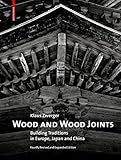Wood and Wood Joints : Building Traditions of Europe, Japan and China / Klaus Zwerger.
Material type: TextPublisher: Basel : Birkhäuser, [2023]Copyright date: ©2023Edition: 3. AuflDescription: 1 online resource (340 p.)Content type:
TextPublisher: Basel : Birkhäuser, [2023]Copyright date: ©2023Edition: 3. AuflDescription: 1 online resource (340 p.)Content type: - 9783035624809
- 9783035624847
- Building, Wooden -- China
- Building, Wooden -- Europe
- Building, Wooden -- Japan
- Framing (Building) -- China
- Framing (Building) -- Europe
- Framing (Building) -- Japan
- Timber joints
- Architektur
- Bautechnik
- Holz
- Konstruktion
- Nachhaltigkeit
- Tradition
- Werkstoff
- ARCHITECTURE / Methods & Materials
- architecture
- building technology
- construction
- material
- sustainability
- wood
- 694/.2 23/eng/20230330
- TH2301 .Z9413 2023
- TH2301 .Z9413 2023
- online - DeGruyter
- Issued also in print.
| Item type | Current library | Call number | URL | Status | Notes | Barcode | |
|---|---|---|---|---|---|---|---|
 eBook
eBook
|
Biblioteca "Angelicum" Pont. Univ. S.Tommaso d'Aquino Nuvola online | online - DeGruyter (Browse shelf(Opens below)) | Online access | Not for loan (Accesso limitato) | Accesso per gli utenti autorizzati / Access for authorized users | (dgr)9783035624847 |
Frontmatter -- Contents -- Foreword -- Introduction to the Fourth, Revised and Expanded Edition -- The Material -- Working with Wood -- Types and Functions of Wood Joints -- Wood Joints and Their Evolution -- Wood Joints as an Expression of Aesthetic Values -- Structural Timber Construction in China -- Bibliography -- Acknowledgements -- About the Author -- Index of Persons and Buildings -- Index of Places -- Subject Index
restricted access online access with authorization star
http://purl.org/coar/access_right/c_16ec
Das Bauen mit Holz als einem gestalterisch eigenständigen und ökologisch sinnvollen Werkstoff hat eine lange Tradition. In Jahrtausenden entstandene Holzarchitektur vermittelt der heutigen Zeit das vielfältige Wissen westlicher und östlicher Kulturen über den schöpferischen Umgang mit diesem unverwechselbaren Material. Bei der typischen Technik des Bauens mit Holz, der reinen Holzverbindung, werden die Elemente ohne materialfremde Hilfe, ohne Leim oder Metall, nur durch das gekonnt entworfene Ineinander der konstruktiven Teile verbunden. Zur höchsten Blüte gelangte die Kunst der Holzverbindung in Japan, das viele Anregungen und Ideen aus China übernahm und weiter entwickelte. Aber auch in europäischen Ländern haben sich einflussreiche Formen entwickelt. Deshalb wird hier die Geschichte der Holzarchitektur in ihren technischen, ästhetischen und ökologischen Dimensionen detailgenau anhand von vielen hundert Beispielen aus Japan, China und neunzehn europäischen Ländern beschrieben. Die Schönheit der Holzbauten und ihrer Details vermittelt sich in brillanten Duotonabbildungen. In anschaulichen dreidimensionalen Zeichnungen offenbart sich das geheime Innenleben der Holzverbindungen. Auch auf deutsch erhältlich (ISBN 978-3-0356-2479-3)
There is a long tradition of using wood as a distinct and ecologically sound building material. Wooden architecture conveys for today’s world the breadth of knowledge held in Western and Eastern cultures about the creative use of this unique material. The typical technique of building with wood, joinery, requires that elements are connected only by the skillful interlocking of the constructive parts. In this book, the history of wooden architecture is described in detail using hundreds of examples from Japan, China and Europe. From a holistic understanding, a picture emerges that is informative for architects, and designers, reopens an almost lost world to builders, and will enthrall laypeople. Also available in a German edition (ISBN 978-3-0356-2479-3)
Issued also in print.
Mode of access: Internet via World Wide Web.
In English.
Description based on online resource; title from PDF title page (publisher's Web site, viewed 26. Apr 2024)


